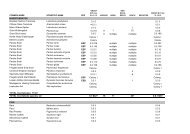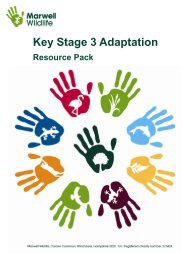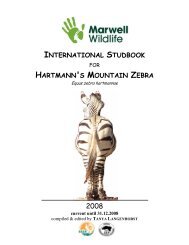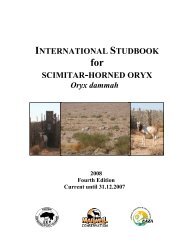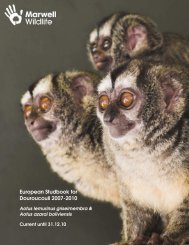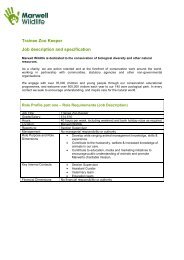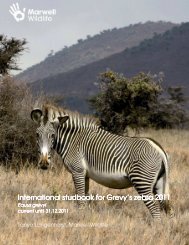International International studbook for Grevy's zebra ... - Marwell Zoo
International International studbook for Grevy's zebra ... - Marwell Zoo
International International studbook for Grevy's zebra ... - Marwell Zoo
Create successful ePaper yourself
Turn your PDF publications into a flip-book with our unique Google optimized e-Paper software.
Introduction<br />
Introduction<br />
Welcome to the most recent edition of the <strong>International</strong> <strong>studbook</strong> <strong>for</strong> Grevy’s <strong>zebra</strong>. It has been another<br />
eventful year and you can find in<strong>for</strong>mation on developments in the field followed by status and changes<br />
throughout 2010 in the zoo world on the following pages.<br />
I would like to thank all of you <strong>for</strong> cooperating with the <strong>studbook</strong> and the breeding programmes <strong>for</strong> the<br />
benefit of this wonderful species.<br />
PLEASE, WOULD ALL REGISTRARS (HOLDERS AND OWNERS) ENTER THE PERMANENT STUDBOOK NUMBERS IN<br />
THEIR RECORDS TO MAKE FUTURE COMMUNICATION ABOUT INDIVIDUAL ANIMALS EASIER. THANK YOU!<br />
Captive Captive Population:<br />
Population:<br />
The total number of <strong>Grevy's</strong> Zebra in captivity as reported to the <strong>studbook</strong> keeper by 31 st December 2010<br />
was 188.303.0 (491) in 114 institutions. Of this 91.148.0 (239) in 52 institutions are in the EEP. This is<br />
based on the last known in<strong>for</strong>mation from each institution up to that time.<br />
An annual breakdown of births and deaths during 2010 is as follows:<br />
World wide 2010 EEP 2010<br />
Total births reported: 21.20.0 (41) Total births reported: 12.12.0 (24)<br />
Total deaths reported: 22.22.0 (44) Total deaths reported: 12.12.0 (24))<br />
Photo Photo Identification:<br />
Identification:<br />
Identification:<br />
With the advances in digital technology it is now easier than ever to take photos of your Grevy’s <strong>zebra</strong> and<br />
send them to the international <strong>studbook</strong> coordinator. A large database <strong>for</strong> these pictures is already in place,<br />
but many photos are still outstanding. The correct recording of a photo in one central location (with the<br />
<strong>studbook</strong> keeper) has several benefits:<br />
1. It safeguards your <strong>zebra</strong>’s identity, even if a transponder has been lost.<br />
2. It allows the identification of animals which were sent out of coordinated programmes like the SSP or<br />
EEP and reported as lost-to-follow-up, and are potentially re-entering those programmes at a later<br />
stage.<br />
3. In some countries and regions, it is now necessary to have individual passports <strong>for</strong> wild equids. A<br />
complete set of specimen report, pedigree and identification photo can be provided by the <strong>studbook</strong><br />
keeper, if all photos are recorded with her.<br />
I would there<strong>for</strong>e urge you all to provide digital photos to the <strong>studbook</strong> where possible. If you are unsure if<br />
you have sent photos to the <strong>studbook</strong> keeper already, please do not hesitate to ask.<br />
Husbandry Husbandry Guidelines:<br />
Guidelines:<br />
EEP African Equids Husbandry Guidelines, edited by Ulrike Rademacher and Achim Winkler, were<br />
published by Wilhelma <strong>Zoo</strong>, Stuttgart in 2000. For EAZA members available on the EAZA website as a PDF.<br />
Wild Wild Status:<br />
Status:<br />
The IUCN Red Data Book 2009 lists <strong>Grevy's</strong> <strong>zebra</strong> as Endangered A2ac; C2a(i);assessed 2008 by<br />
Moehlman, P.D., Rubenstein, D.I. & Kebede, F. Justification: Listed as Endangered as <strong>Grevy's</strong> Zebra is<br />
estimated to have declined by more than 50% over the past 18 years based on direct observation and<br />
potential/actual levels of exploitation. In addition, the current total population is estimated at 750 mature<br />
individuals, with the largest subpopulation estimated at 255 mature individuals. Listed on CITES Appendix I,<br />
<strong>Grevy's</strong> Zebra are legally protected in Ethiopia, although official protection has been limited. Communitybased<br />
conservation has been more effective. In Kenya, they have been protected by a hunting ban since<br />
1977. While under the Wildlife Conservation and Management Act No 376 of 1976 (Part II of the First<br />
Schedule), Grévy’s Zebra was listed as a ‘Game Animal’ (Williams 2002); they are currently being uplisted<br />
to a legally ‘Protected Animal’ in Kenya. (Moehlman, P.D., Rubenstein, D.I. & Kebede, F. 2008).<br />
www.iucnredlist.org<br />
Tanya Langenhorst, <strong>International</strong> <strong>studbook</strong> keeper, <strong>Marwell</strong> Wildlife<br />
AI





